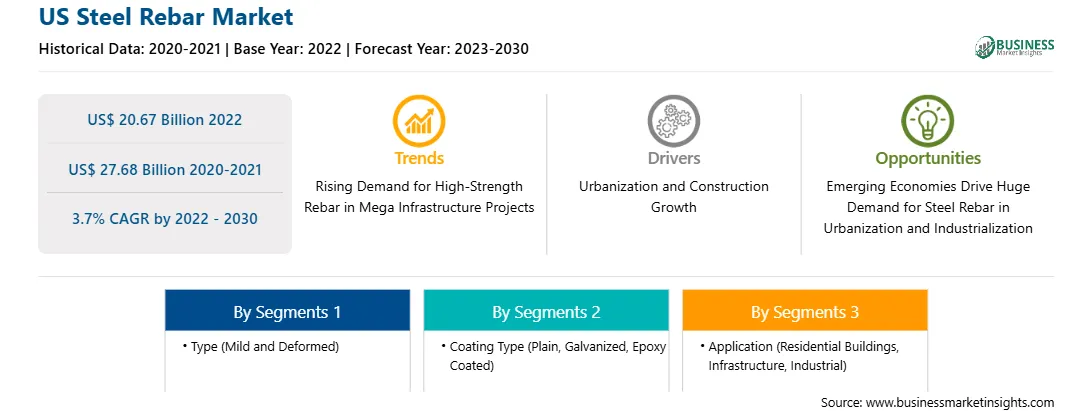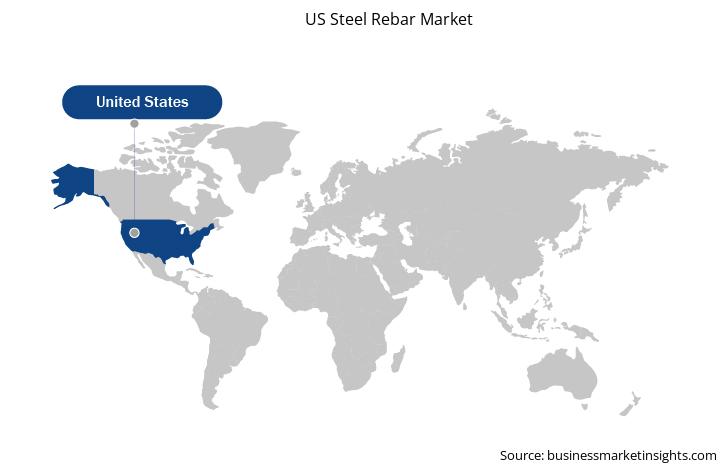The US steel rebar market is expected to grow from US$ 20.67 billion in 2022 to US$ 27.68 billion by 2030; it is expected to register a CAGR of 3.7% from 2022 to 2030.
Steel rebar is a critical component in the construction industry, reinforcing and strengthening concrete structures. The increasingly high-strength steel, typically with ribbed surfaces, is strategically placed within concrete to enhance strength. This reinforcement is crucial because concrete excels in compression but has limited tensile strength and is prone to cracking under tension. The design of steel rebar involves a careful balance of flexibility and strength, allowing it to withstand various structural loads. The ribbed patterns on the surface of the rebar enhance its bond with the surrounding concrete, preventing slippage and ensuring effective load transfer between the two materials. The use of steel rebar is a testament to the synergy between materials in construction, combining the compression strength of concrete with the tensile strength of steel to create durable and resilient structures capable of withstanding diverse environmental conditions and loads over time.
In residential construction, steel rebar plays a crucial role in reinforcing concrete foundations, columns, and beams. The durability and strength provided by steel rebar are essential for ensuring the longevity and structural integrity of residential buildings. This is particularly significant in regions prone to seismic activity, where the use of reinforced concrete structures supported by steel rebar is essential for meeting stringent safety standards. Additionally, the trend toward sustainable and resilient construction practices further supports the demand for steel rebar. As builders and developers focus on constructing energy-efficient and environmentally friendly residential buildings, the use of reinforced concrete featuring steel rebar aligns with these objectives. Steel rebar's recyclability and ability to enhance structures' longevity contribute to the overall sustainability of residential construction projects. The residential construction sector is expanding with growing private and US government investments. For instance, in 2021, the US government is also focusing on providing affordable housing. As part of the BBB plan, the government allocated an investment of US$ 150 billion on affordable housing provisions to construct and rehabilitate over 1 million affordable homes across the country. This increased government investment is expected to increase the demand for residential construction materials, which is expected to boost the US steel rebar market growth. Noncorrosive properties are becoming increasingly important in construction materials, especially in areas with high humidity or proximity to saltwater. Traditional rebars are susceptible to corrosion, which can compromise the structural integrity of a building over time. The demand for noncorrosive steel rebars has upsurged as they offer longevity and durability, reducing maintenance costs and ensuring the safety and stability of structures over their lifespan. Thus, the rising demand for lightweight, high-strength, and noncorrosive rebars drives the US steel rebar market growth.
Moreover, Steel rebars play a vital role in the construction of residential buildings as they provide crucial reinforcement to concrete structures. The rebars are commonly used in the foundation of homes, where they are strategically placed within the concrete to enhance its tensile strength. The reinforcement helps the foundation withstand the structural loads the building imposes, ensuring stability and durability over time. Steel rebars are often used in residential construction to construct reinforced concrete columns and beams. These elements support the overall framework of the building, distributing loads efficiently and preventing structural failure. Using rebars in columns and beams contributes to the building's ability to resist external forces, such as wind, earthquakes, and the structure's weight.
Moreover, steel rebars have applications in the construction of slabs and floor systems within residential buildings. Reinforced concrete slabs benefit from the added strength and flexibility provided by properly placed rebars, whether for ground floors or upper levels. In the context of residential buildings, steel rebars are essential in reinforced concrete walls. This application enhances the walls' load-bearing capacity and resistance to lateral forces. Additionally, rebars may be used in constructing balconies, stairs, and other structural elements, contributing to the overall safety and integrity of the residential buildings. Surging demand from these residential construction is expected to drive the US steel rebar market growth.
A few key players operating in the US steel rebar market are Steel Edge Inc, InteRebar Fabricators LLC, JJ Rebar Corp, Pacific Steel Group, PJ's Rebar Inc, Integrity Rebar Placers, Nucor Harris Rebar Inc, Camblin Steel Services Inc, Northern Nevada Rebar Inc, and Bellis Steel Co Inc. Players operating in the market are highly focused on developing high-quality and innovative product offerings to fulfill customers' requirements.
The overall US steel rebar market size has been derived using both primary and secondary sources. Exhaustive secondary research has been conducted using internal and external sources to obtain qualitative and quantitative information related to the market. Also, multiple primary interviews have been conducted with industry participants to validate the data and gain more analytical insights into the topic. The participants of this process include industry experts, such as VPs, business development managers, market intelligence managers, and national sales managers-along with external consultants, such as valuation experts, research analysts, and key opinion leaders-specializing in the US steel rebar market.
Strategic insights for the US Steel Rebar provides data-driven analysis of the industry landscape, including current trends, key players, and regional nuances. These insights offer actionable recommendations, enabling readers to differentiate themselves from competitors by identifying untapped segments or developing unique value propositions. Leveraging data analytics, these insights help industry players anticipate the market shifts, whether investors, manufacturers, or other stakeholders. A future-oriented perspective is essential, helping stakeholders anticipate market shifts and position themselves for long-term success in this dynamic region. Ultimately, effective strategic insights empower readers to make informed decisions that drive profitability and achieve their business objectives within the market.

| Report Attribute | Details |
|---|---|
| Market size in 2022 | US$ 20.67 Billion |
| Market Size by 2030 | US$ 27.68 Billion |
| Global CAGR (2022 - 2030) | 3.7% |
| Historical Data | 2020-2021 |
| Forecast period | 2023-2030 |
| Segments Covered |
By Type
|
| Regions and Countries Covered | United States
|
| Market leaders and key company profiles |
The geographic scope of the US Steel Rebar refers to the specific areas in which a business operates and competes. Understanding local distinctions, such as diverse consumer preferences (e.g., demand for specific plug types or battery backup durations), varying economic conditions, and regulatory environments, is crucial for tailoring strategies to specific markets. Businesses can expand their reach by identifying underserved areas or adapting their offerings to meet local demands. A clear market focus allows for more effective resource allocation, targeted marketing campaigns, and better positioning against local competitors, ultimately driving growth in those targeted areas.

The List of?Companies - US Steel Rebar Market
- Steel Edge Inc
- InteRebar Fabricators LLC
- JJ Rebar Corp
- Pacific Steel Group
- PJ\'s Rebar Inc
- Integrity Rebar Placers
- Nucor Harris Rebar Inc
- Camblin Steel Services Inc
- Northern Nevada Rebar Inc
- Bellis Steel Co Inc
The US Steel Rebar Market is valued at US$ 20.67 Billion in 2022, it is projected to reach US$ 27.68 Billion by 2030.
As per our report US Steel Rebar Market, the market size is valued at US$ 20.67 Billion in 2022, projecting it to reach US$ 27.68 Billion by 2030. This translates to a CAGR of approximately 3.7% during the forecast period.
The US Steel Rebar Market report typically cover these key segments-
The historic period, base year, and forecast period can vary slightly depending on the specific market research report. However, for the US Steel Rebar Market report:
The US Steel Rebar Market is populated by several key players, each contributing to its growth and innovation. Some of the major players include:
The US Steel Rebar Market report is valuable for diverse stakeholders, including:
Essentially, anyone involved in or considering involvement in the US Steel Rebar Market value chain can benefit from the information contained in a comprehensive market report.